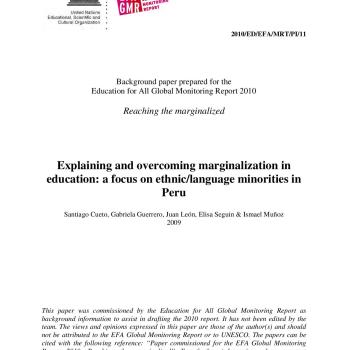
In the past few decades, education in Peru has shown a tendency to increased enrollment, especially in primary schools, and consistent low achievement as measured by national and international standardized tests in reading comprehension and mathematics. However, averages hide wide disparities in diverse educational outcomes, which are often times marked by individual and family characteristics. Among these, coming from an indigenous speaking family has been shown to be an important predictor of low educational outcomes as compared to the majority of Spanish-speaking children. It is important to note from the outset however, as shown below, that having an indigenous maternal language is also associated with other individual and family characteristics, such as being poor and living in a rural environment; and that these two are also associated with low educational achievement. The combination of these variables makes for a compounded negative effect on educational outcomes. Peruvian law and international agreements, such as the goals set forth in Education For All, call for a reduction in inequalities and increase of educational quality.
The purpose of this paper is to present and discuss empirical information on the educational opportunities and outcomes of indigenous speaking children as compared to their Spanish-speaking counterparts in Peru. This paper is organized as follows: after a brief introduction we present several social and economic indicators for indigenous and Spanish-speakers in Peru. The third section presents descriptive information on diverse educational outcomes for these groups and a multivariate analysis of the determinants of achievement, decomposing the factors that predict the gap between indigenous and Spanish-speakers. The fourth section describes intercultural bilingual policies and its implementation. The final section presents some preliminary conclusions and suggestions for further research and policies. For the analysis we rely on several secondary data sources; however all estimates presented below were calculated by the authors. References to previous studies on relevant topics, performed in Peru and Latin America, are included throughout the paper.
ReferenceSantiago Cueto, Gabriela Guerrero, Juan León, Elisa Seguin & Ismael Muñoz (2010) 'Explaining and Overcoming Marginalization in Education: A Focus on Ethnic/Language Minorities in Peru', background paper prepared for the EFA Global Monitoring Report 2010: Reaching the Marginalised, UNESCO: Paris.

In the past few decades, education in Peru has shown a tendency to increased enrollment, especially in primary schools, and consistent low achievement as measured by national and international standardized tests in reading comprehension and mathematics. However, averages hide wide disparities in diverse educational outcomes, which are often times marked by individual and family characteristics. Among these, coming from an indigenous speaking family has been shown to be an important predictor of low educational outcomes as compared to the majority of Spanish-speaking children. It is important to note from the outset however, as shown below, that having an indigenous maternal language is also associated with other individual and family characteristics, such as being poor and living in a rural environment; and that these two are also associated with low educational achievement. The combination of these variables makes for a compounded negative effect on educational outcomes. Peruvian law and international agreements, such as the goals set forth in Education For All, call for a reduction in inequalities and increase of educational quality.
The purpose of this paper is to present and discuss empirical information on the educational opportunities and outcomes of indigenous speaking children as compared to their Spanish-speaking counterparts in Peru. This paper is organized as follows: after a brief introduction we present several social and economic indicators for indigenous and Spanish-speakers in Peru. The third section presents descriptive information on diverse educational outcomes for these groups and a multivariate analysis of the determinants of achievement, decomposing the factors that predict the gap between indigenous and Spanish-speakers. The fourth section describes intercultural bilingual policies and its implementation. The final section presents some preliminary conclusions and suggestions for further research and policies. For the analysis we rely on several secondary data sources; however all estimates presented below were calculated by the authors. References to previous studies on relevant topics, performed in Peru and Latin America, are included throughout the paper.
ReferenceSantiago Cueto, Gabriela Guerrero, Juan León, Elisa Seguin & Ismael Muñoz (2010) 'Explaining and Overcoming Marginalization in Education: A Focus on Ethnic/Language Minorities in Peru', background paper prepared for the EFA Global Monitoring Report 2010: Reaching the Marginalised, UNESCO: Paris.

